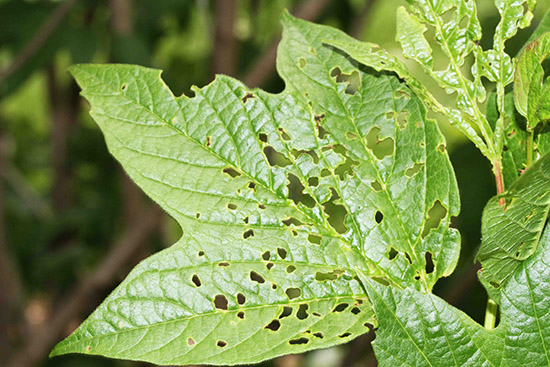Issue 5, May 30, 2017
Viburnum Leaf Beetle
Obvious damage by viburnum leaf beetle is being found in northern Illinois. Eggs overwinter and hatch in May into yellow to brown larvae with black dots which feed on the undersides of viburnum leaves. The feeding damage is very characteristic as both the larvae and adults eat elongated oval areas of leaf tissue between lateral veins, creating an interesting angling damage pattern on heavily attacked leaves. Heavily attacked shrubs are defoliated, and those defoliated two to three years in succession are likely to die.

Viburnum leaf beetle larvae and damage.
Larvae grow to about one-third inch long and drop to the soil to pupate, emerging as adult beetles in July to feed on the leaves through the rest of the summer. Adult beetles are a drab shade of yellow-green to brown and are one-quarter to one-third inch long.
Female beetles lay eggs into one-eighth inch diameter pits that they chew in rows into small twigs, primarily twigs produced earlier in the year. They cover the eggs with frass, a mixture of fecal matter and wood and bark fragments, whose appearance is different from the surrounding bark when deposited. Over time, the color difference becomes less obvious. These eggs hatch the following spring.
Many viburnum species are fed upon, but the insect prefers species whose leaves are less hairy such as European cranberrybush, American cranberrybush, and arrowwood viburnum. Damage is reduced by planting less preferred viburnum species such as Koreanspice, Burkwood, Judd, carlcephalum, leatherleaf, lantanphyllum, Japanese snowball, tea, and Siebold viburnums. Other viburnums are intermediate in feeding preference.

Viburnum leaf beetle larval damage to American cranberry bush.
Pruning and destroying twigs containing eggs in the fall and winter reduces larval numbers the following spring. Acephate (Orthene), carbaryl (Sevin), cyfluthrin (Tempo), imidacloprid (Merit), lambda-cyhalothrin (Scimitar), spinosad (Conserve), and malathion are effective. A spray application to young larvae in the spring is most effective in preventing damage. A second spray may be needed later in the growing season to control heavy adult feeding. (Phil Nixon)
Author:
Phil Nixon